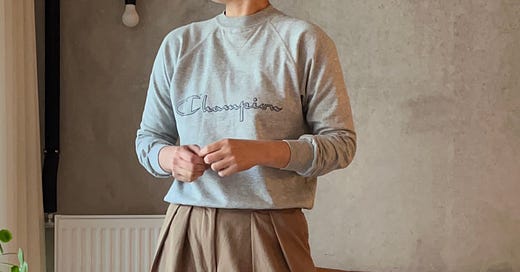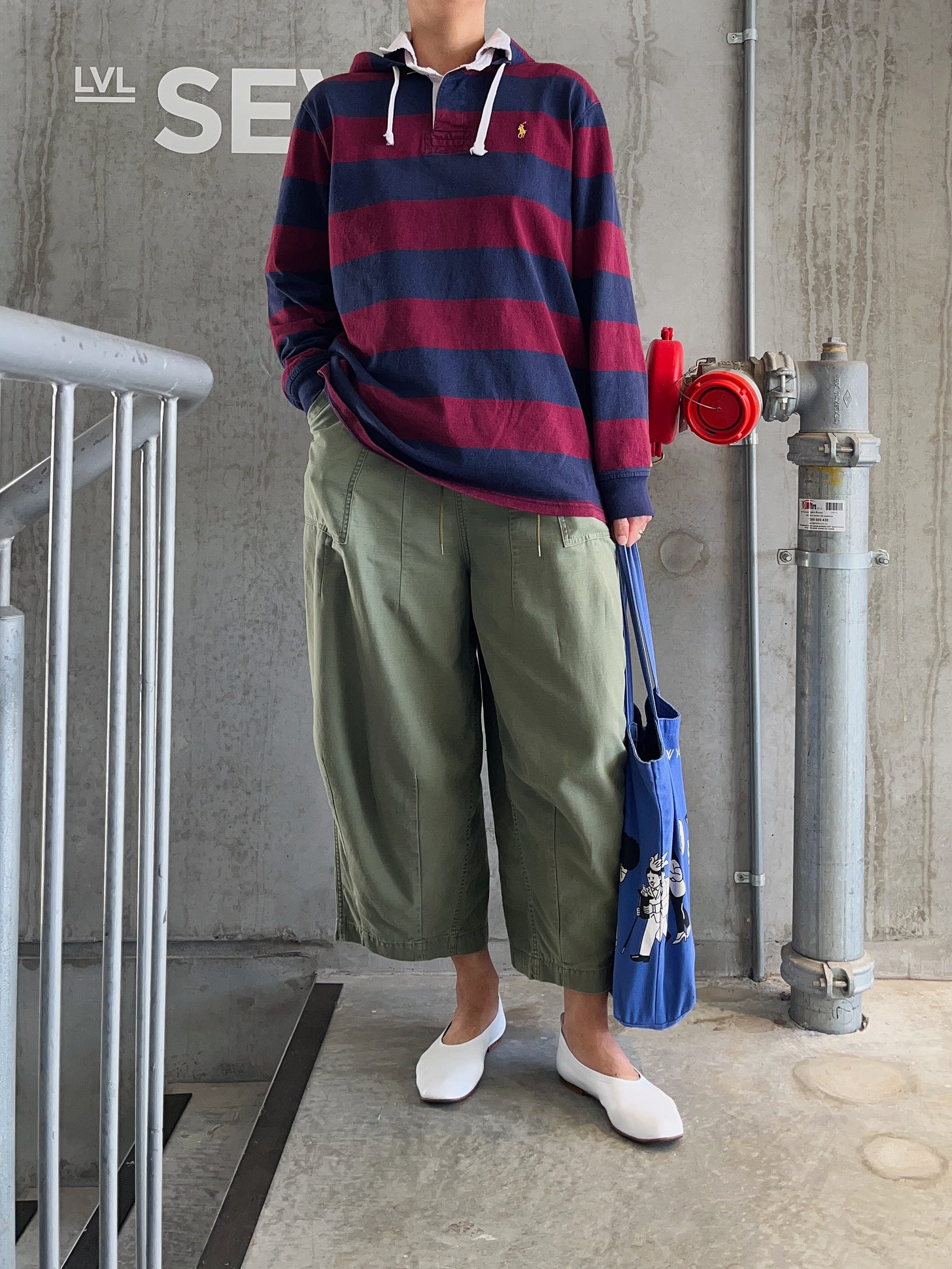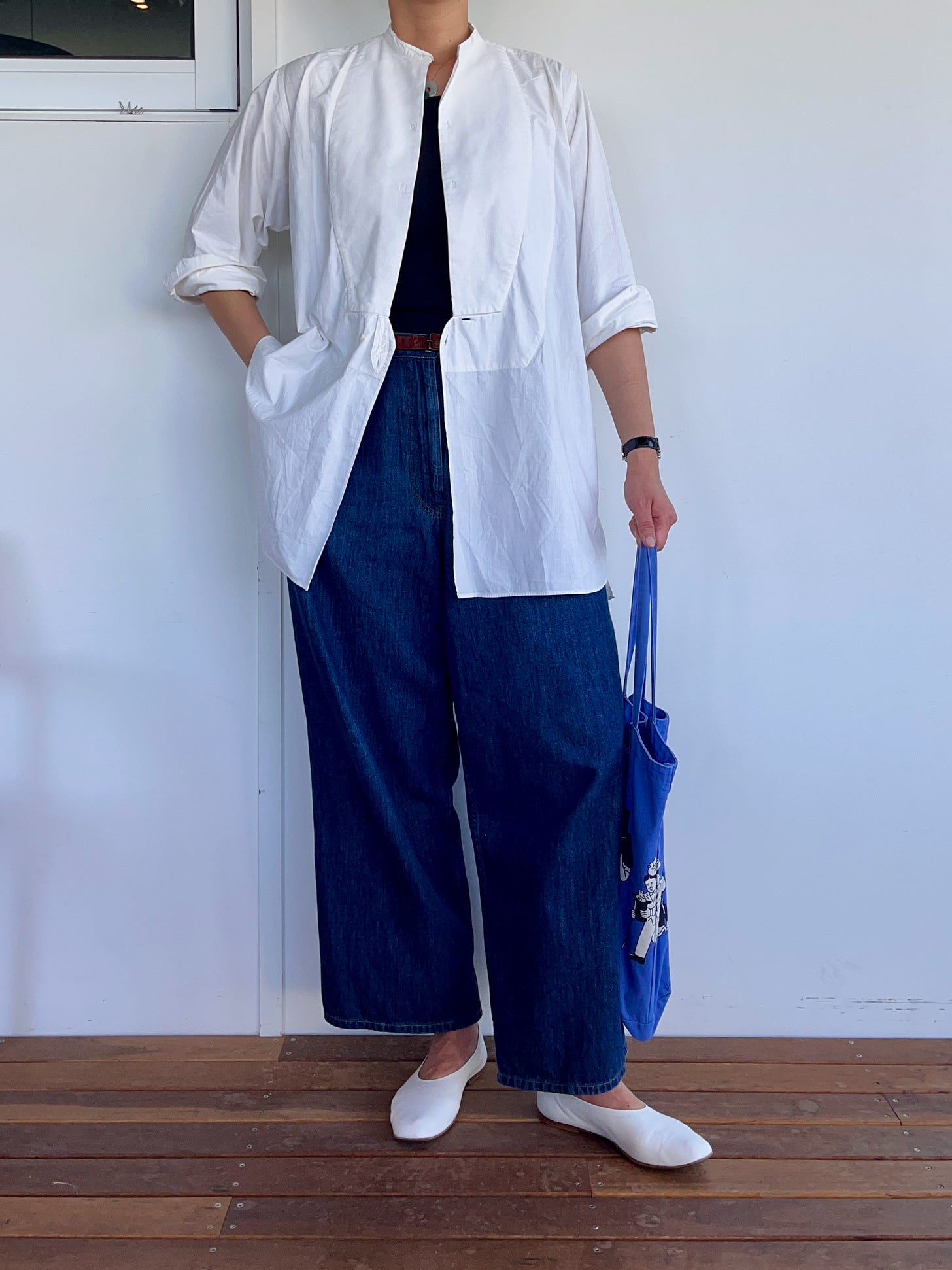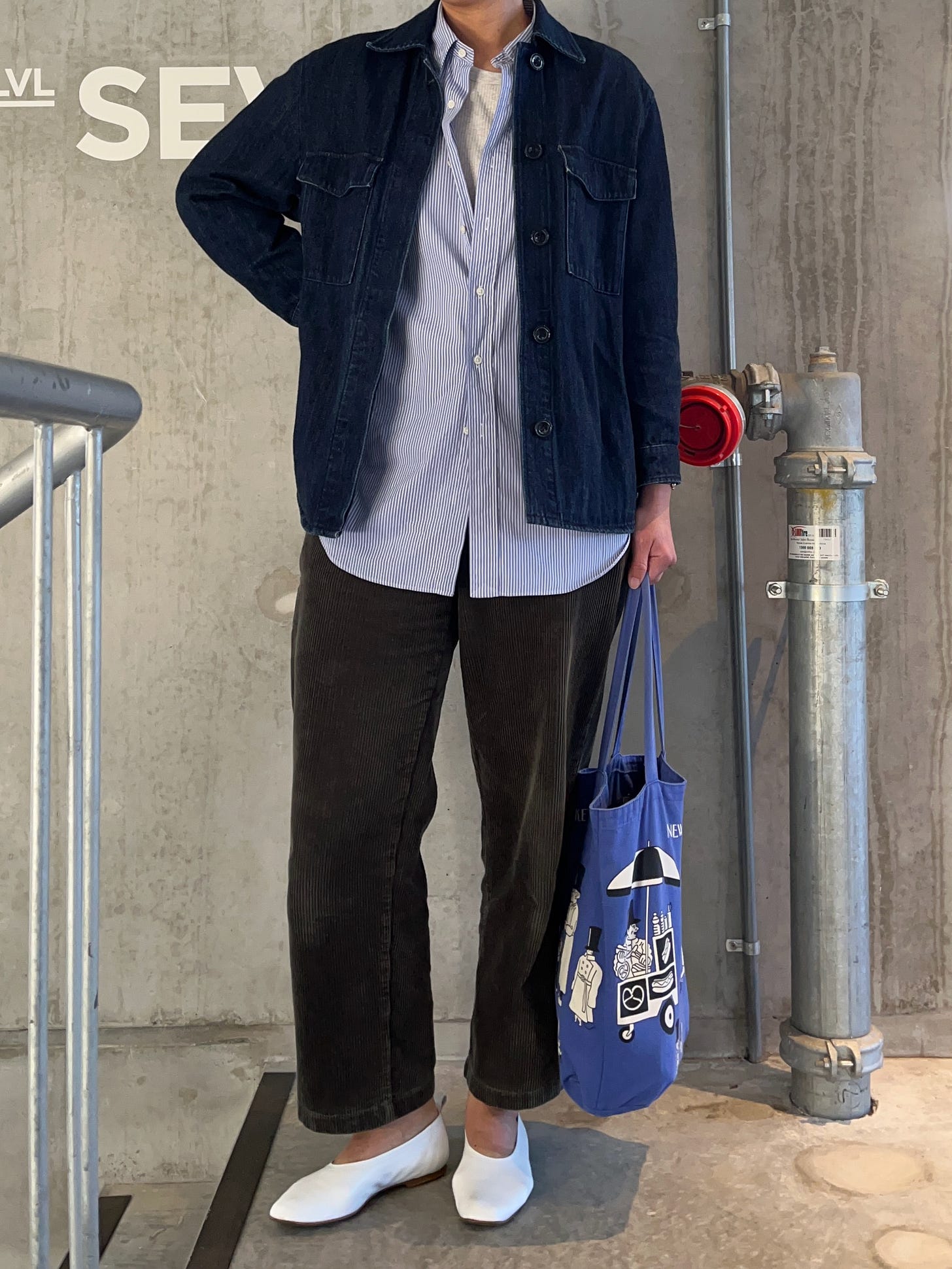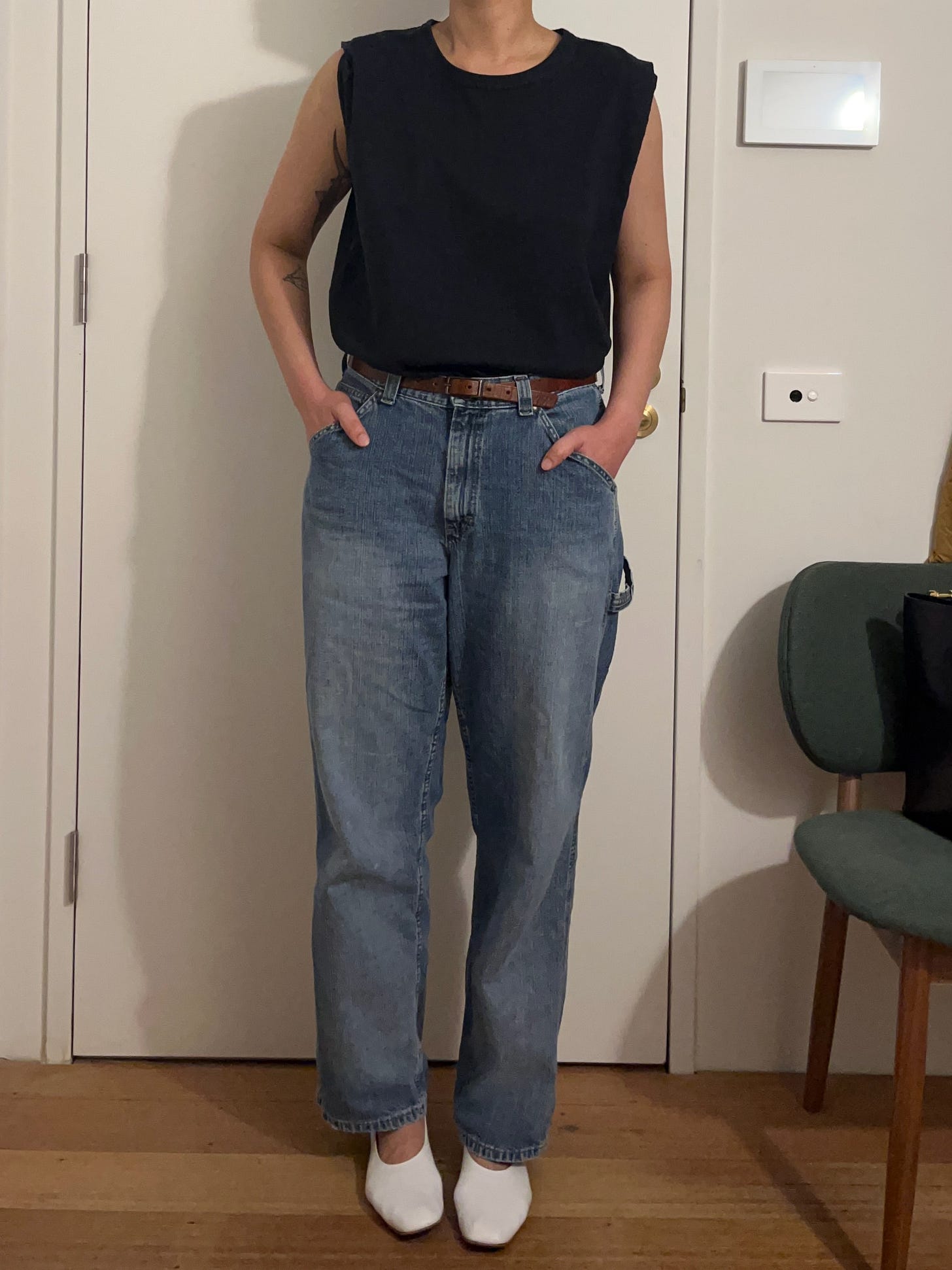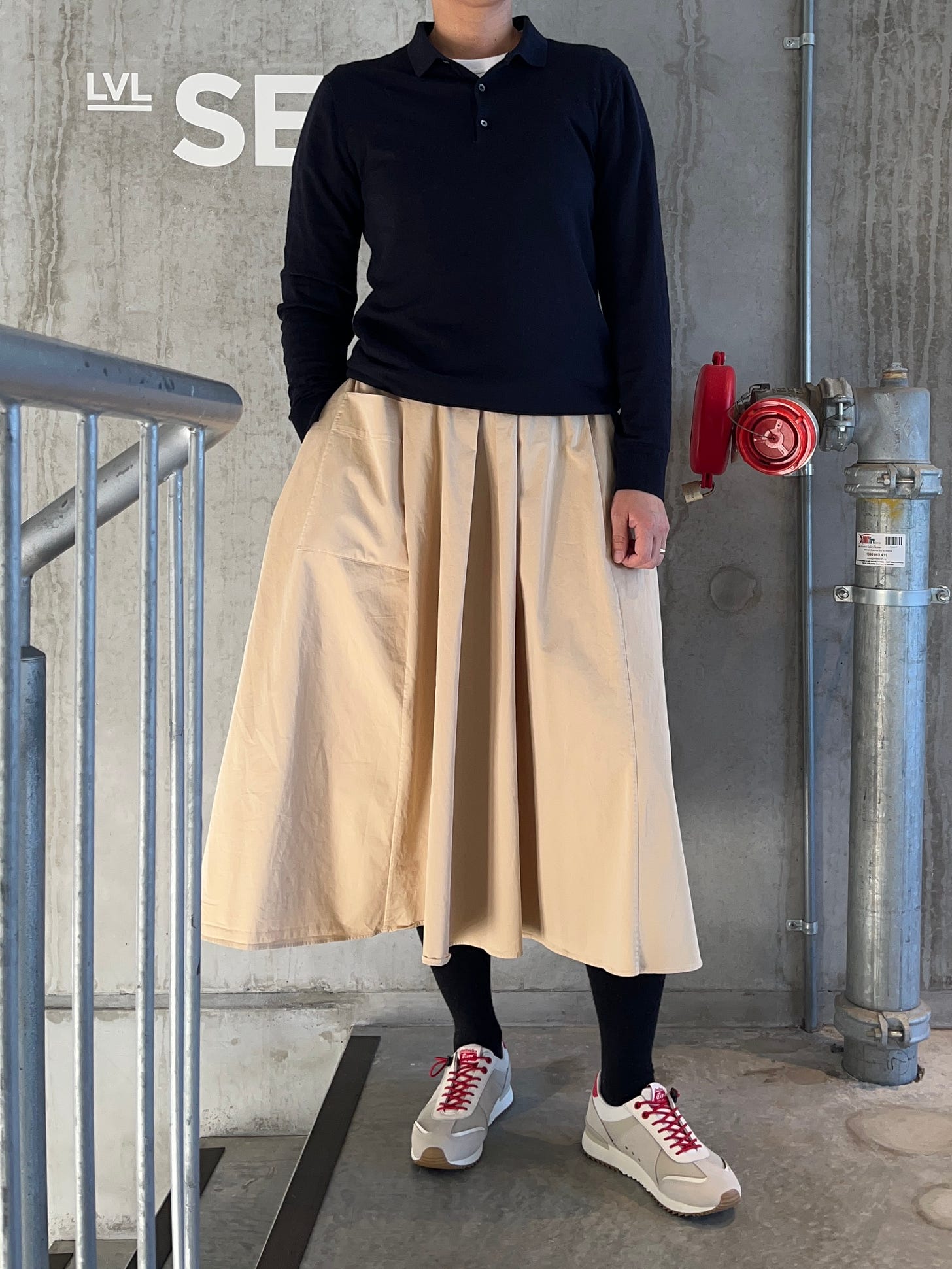style story: lin from out of the bag
"you just start to question what’s being sold to you"
I’ve been following and her style for close to twenty years. I believe I first saw her on a predecessor to Instagram, a group on the photo hosting platform Flickr called “Wardrobe Remix”, which was the first place I ever saw “real” people posting their outfits. I followed her blog for a while but eventually lost track of her. Imagine my delight when I found her Substack, Out of the Bag! I’ve always loved Lin’s minimalist yet fashion forward style. There are many people doing “no buy” and “low buy”’s right now, and Lin’s slow and thoughtful approach to style should be required reading. A note: Lin prefers to be anonymous which is why you won’t see her face in any of the images. This post will be too long for email, so make sure to click through to see it all!
Please enjoy!
Q: Introduce yourself, your work, and how you spend your time.
A: I’m Lin, and I’m from Singapore, but currently living in Melbourne. I was a journalist, and producer, and now I do commercial writing and editing on a freelance basis while studying part-time.
My days are mostly spent at home working or studying, which can make me feel a little stir-crazy so I try and spend part of week working in a library or cafe, just to feel connected to the outside world.
Q: What was your style like when you were a child?
A: I was and am very conscious of how I dressed because that’s just how it was with my family. My late mother loved clothes, and she and her sisters could discuss for hours what to wear to important family occasions; my sisters and I are the same.
I remember as a child I had very obvious “feminine” preferences—a navy velvet dress with a frilly white skirt comes to mind when I think of a memorable childhood outfit, My older sister had the dress first and I lived for the day it was handed down to me.
But I think I always had a tomboy side too—I remember coveting overalls but my mum hated them cos she thought it was a pain to change us or for us to use the bathroom, which is a fair point. She did however indulge my love for jeans; I recall an early outfit of straight cut jeans worn with a white shirt that had buttons that looked like gemstones. I was maybe 9 or 10, and I remember feeling very stylish.
Q: Growing up, what messages were you given about what you should or shouldn’t wear (and from whom or where do you think those messages came)?
A: My sisters and I are all fairly tall and broad, and my mum used to lament the “big hips” that we inherited from her, so from a young age, I was conscious of dressing to flatter or minimise the appearance of my hips. All of us are above average height and size for Asian women, and I remember going shopping as a teenager and struggling to find clothes from local brands that fit — I was always told ‘we don’t make things in your size’. And I was at most a US6 or 8 at the time.
I knew I was far from fat, but I felt outside of what was “ideal”, so it’s not surprising that I internalised the need to dress to look slimmer and “flatter” the “good” parts of my body. I’m still processing this — on one hand I don’t care to look thin anymore, but on the other hand, I still don’t like clothes that hit the widest parts of my body. Not sure if I will ever be free of these instincts!
Q: How has your style evolved since you were younger and what phases have you gone through with your style (i.e. high school grunge phase, early working days business casual phase, etc)?
A: I wore a school uniform from age 7 to 18 so there wasn’t a lot of style exploration during those years, but I consumed a lot of books, movies and magazines related to style and fashion, and I was extremely attuned to what people around me were wearing. My older sis, a true Gen X girl, influenced me a lot of with her tastes in music, movies and TV and I loved all the grunge looks she and her friends wore - slip dresses with plaid shirts etc.
By the time I was a teenager it was full-on Y2K style so it was all low-slung jeans or cargo pants with baby tees. But at the same time, I was reading a lot of secondhand Vogue from so I was really influenced by 1990s minimalism and the greats — Jil Sander, Helmut Lang, Calvin Klein, Ann Demeulemeester. I was in awe of that level of sophistication and cool, and looking back now, I can see how it was also really avant garde compared to what came before.
I was also very influenced by what I saw in the movies (Thelma and Louise was a big influence, Tank Girl was another one) and what my favourite musicians wore— Cantopop queen Faye Wong, Shirley Manson from Garbage, Gwen Stefani during her No Doubt years, the Spice Girls.
My uni days and early 20s were all about what we now call Indie sleaze—the reigning style queen at this point was Alexa Chung. I wore a lot of skinny jeans and “French girl” tops—Bretons, cotton blouses or shirts, very APC-ish things, and those American Apparel skater skirts. With ballet flats, always. For clubbing, I would add some colourful tights. When I graduated university, my work environment was pretty casual so I could still wear all of those things and just throw on a blazer to pull it together.
As my career progressed, I wanted to look more “professional”, and I went through a preppy/classic/“French chic” phase, followed by a “Scandi minimal” phase. I became more interested in fashion history as well - the history of prep was fascinating to me, and I had a “trad” menswear phase when I went deep into how tailored clothing was made and how suits are meant to fit. It wasn’t so much the style I wanted to emulate, it was simply a universe that had a language and framework for how good clothes were made, and it taught me a lot about how to look for good quality and how to assess fit.
During this time, I became more invested in buying better quality things because I finally had the means to do so, and actually a lot of the clothes from this time lasted for a long time and kept up with my changing tastes. It was painful to sell/give them away when they no longer fit.
My style continues to evolve, but overall I still favour clothes that are pared back and minimal in nature, and I love designs that are inspired by function and utility, and I am very drawn to materials where you can really feel the workmanship, like good quality linen, cotton, denim and wool. These days, I am less invested in having “personal style” or identifying with a specific style or subculture, and I approach style more intuitively.
Q: How have external pressures to conform to the ideal standard of beauty and the thought of how others view you affected your style?
A: I’d always felt like I had to dress to look thin and emphasise the parts of my body that were conventionally considered attractive. I’m straight sized by western standards, but you’ve ever lived in Southeast Asia, you’d know that I was basically a giant by local standards. Most local brands did not carry clothes in my size and most international brands were out of my budget as a teenager. When brands like Topshop and Mango were introduced in Singapore in the late 90s, it was a huge relief for me because I could finally buy clothes that fit me.
Because I’ve always preferred clothes that fit loosely on me, I started shopping from the mens’ section early - this was well before the current craze for oversized everything, and it was hard to find women’s styles that fit loosely on me, especially bottoms.
I think this forever changed how I perceived womenswear - it was such a relief to find clothes that had real pockets! And maybe this is no longer the case, but menswear for a time seemed better quality too — the t-shirts are thicker, the jeans are heavier, the shirting is less flimsy. I’m not saying we have to choose between the two, but shopping menswear did raise my standards of what to expect from clothes overall and to see how men and women are catered to differently.
Q: How have your sense of style and shopping habits shifted along with changes in your body?
A: I’ve gone up about 2 sizes but I think my style influences haven’t changed - I still like jeans, t-shirts, interesting trousers, workwear-inspired styles and I still favour the same colours and materials.
One thing that’s changed is that over the years, I’ve followed more and more influencers who aren’t skinny, which has made me more attuned to recognising style on all body types, instead of just the types I saw in magazines growing up. My eye had to adjust, but once it did, it was hard to go back to seeing clothes modeled on just one type of body - you just start to question what’s being sold to you, and it is one of the reasons I’ve gradually lost my taste for shopping — I still love clothes but the glow is gone because the industry feels like a minefield. But I do have more appreciation for brands that try to do things differently for the better. For example, I love Elizabeth Suzann and Liz Pape’s openness in sharing about her way of doing business; it has taught me so much about what it takes to do things right.
Q: What barriers do you encounter in trying to express your style? Are there any situations or spaces you feel your style prohibits you from accessing or gives you better access to?
A: I don’t think I’ve encountered very many — I guess I’ve been lucky so far and also, there’s really nothing very unconventional or challenging about the way I dress. I used to be really conscious of being mistaken for a boy — I like masculine/unisex leaning styles but I felt the need to balance it with feminine details or by showing a bit of skin, until I realised it was just really tiring to live like that. But I would say this was mostly a barrier I created for myself, because after I became more confident and started dressing the way I wanted to, I don’t recall actually facing any repercussions.
Q: Do you have any style icons? Who are they?
A: This is such an interesting question. The women I admired and once idolised all have very a restrained, almost disciplined sense of style. I find Sofia Coppola very chic, and I think she has amazing taste and I admire her understated sense of style, but I no longer want to dress like her. Same for Carolyn Bessette Kennedy - her cool, minimalist glamour is extremely inspiring, but I don’t actually want to dress like that; I just admire her exacting taste and sense of restraint.
For more relatable styling, I love Linda V Wright and Hirofumi Kurino — they dress in a way that feels artful and so true to their personalities. And I often think about the musicians I loved when I was younger - Faye Wong, Shirley Manson, Sinead O’ Connor. I love their sense of rebellion. It doesn’t literally translate into how I dress, but that attitude is what I look for when I look at clothes.
Q: How would you define your current relationship to clothes and style?
A: Pretty good. I feel confident about what I like and how I dress. But I feel like I have an unhealthy relationship with shopping - I love that feeling of finding something new to get excited about, but it’s just not sustainable. I don’t want to self-diagnose but it felt a little like an addiction, a little like status anxiety, and I felt it got in the way of me enjoying clothes and fashion. Addressing that head-on has been my focus in the last couple of years.
As for personal style, I had a couple of lost years where there were a lot of life changes - the pandemic, moving countries, being at a career crossroads, changing body shape and size. I did quite a lot of shopping out of necessity, but some of my purchases were very misguided because I was fantasy shopping and comparing myself to others. Over the last 12 months, I’ve felt myself getting back into a good place, where getting dressed feels interesting and thoughtful again, rather than fuelled by insecurity and anxiety.
Q: What makes your style authentic to who you are today?
A: I think authenticity is more a feeling than anything else. Once I let go of how I was supposed to look or what was “cool”, I felt very much myself in whatever I chose to wear - if I want to wear a big floral dress, I wear it, even though it’s different from my usual baggy pants and tee. I’ve stopped trying to cultivate a consistent mood or style, because I think attachment to a fixed ideal (size, aesthetic) is what kills the joy and spontaneity that makes getting dressed a pleasure, and crushes that sense of authenticity.
For example, if I’m drawn to something rather unusual for me, like velvet, I let the idea marinate in my mind until I find the one velvet garment that somehow aligns with my personal style. Or maybe I get over it eventually without buying anything. But I don’t immediately think, “oh velvet is not my aesthetic” because I think that’s limiting.
Q: Do you wear anything that’s conventionally considered unflattering?
A: Maybe when I wear big tops and big bottoms and I don’t “balance” it with a bit of skin or something slim- fitting? I think some people might find that unflattering. But I like the look, especially when the top and trousers have been carefully chosen and have a bit of interest about them in terms of shape, cut, colour or texture. I know that tucking on my shirt would make an outfit look a little more conventionally chic, but sometimes I just feel like, “Nope, I don’t care.”
Lin, thank you so much for sharing yourself and your writing with us! Everyone, go subscribe to Lin’s wonderful newsletter here.
Here are style stories from Virginia Sole-Smith, Virgie Tovar, Jessica Defino, Frankie de la Cretaz, Ajiri Aki, Erika Veurink, Amanda Richards, Shana Minei Spence, Jess Kirby, Bri Campos, Shira Gill, Sushmita Šipraga, and Emma Eisenberg.
Paid subscribers, read on for 3 of Lin’s favorite wardrobe items.


